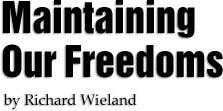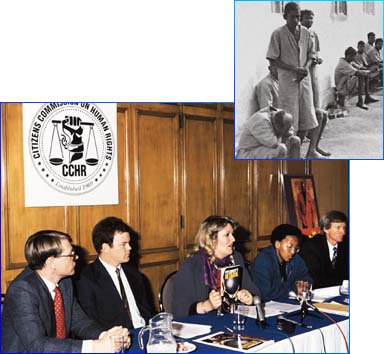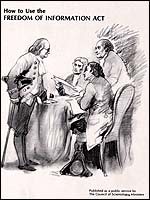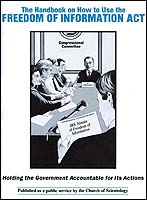

 hroughout history, determined individuals have struggled for the rights and freedoms which we enjoy today. The right to vote, the right to speak freely — these and many others were hard-fought and hard-won. It could well be said that to have any freedom, it must be constantly worked for.
hroughout history, determined individuals have struggled for the rights and freedoms which we enjoy today. The right to vote, the right to speak freely — these and many others were hard-fought and hard-won. It could well be said that to have any freedom, it must be constantly worked for.
Today we see these rights assailed in different ways. Such has also been the case through history. But that we still have rights and freedoms today is testimony to the fact that determined individuals also maintained them – by fighting and exposing those who sought to take them away.
 Today, the Internet stands as arguably the most potent tool for freedom of expression ever developed. The “Net” is on the way to fulfilling everyone’s dream of a free speech medium – a place where anyone can express his thoughts and where one man’s opinion can have instant global impact.
Today, the Internet stands as arguably the most potent tool for freedom of expression ever developed. The “Net” is on the way to fulfilling everyone’s dream of a free speech medium – a place where anyone can express his thoughts and where one man’s opinion can have instant global impact.
With such a powerful communication tool at our fingertips, it is not surprising that many abuses of the medium have emerged, and that just as many efforts to censor or dilute that freedom have also surfaced.
Members of the Church of Scientology know better than many that the freedom to communicate is a vital liberty. And it is a freedom they have fought for tirelessly through the years. In fact, L. Ron Hubbard, founder of the Scientology religion, said, “Perhaps the most fundamental right of any being is the right to communicate. Without this freedom other rights deteriorate.”
But a freedom without responsibility – or vigilant efforts to maintain that freedom – is no freedom at all. And it invites attempts to regulate and usurp it.
Recent history provides singular examples of this – and offers the lesson that no freedom can exist without those who fight to keep it.

Based on a profound and abiding understanding of the importance of free and open communication, members of the Church of Scientology have worked for four decades to support the cause of free speech and the right of the individual to express his opinions without interference.
The actions of Scientologists come from the belief that at the heart of freedom of speech lies the right to speak out against abuses and to voice unpopular and even politically incorrect opinions.
Yet even in a democracy, as history has demonstrated, nonconformity is often viewed as heresy and free speech can too easily be crushed under the weight of government intervention. Examples abound, from FBI director Hoover’s vendetta against Martin Luther King, to the many individuals and groups who found their way onto former President Nixon’s “enemies list.”

In the 1970s, in his book The Gulag Archipelago, Aleksandr Solzhenitsyn graphically portrayed the network of forced labor camps which dotted Siberia and comprised the last stop for dissident Russians whose opinions and actions violated politically accepted state norms.
To Americans already familiar with communist suppression of free speech and free thought, the existence of such detention camps was shocking, though not surprising.
Americans might have been more shocked, however, had they known that some 20 years earlier, psychiatrists in their own country had initiated plans to create a similar political Siberia.
In the mid-1950s, on the heels of the McCarthy era, psychiatric vested interests introduced a bill into the United States Congress to create just such a Gulag.
The bill (H.R. 6376) called for psychiatric facilities to be built in what was then the relatively unpopulated territory of Alaska. The measure included provisions for a national commitment procedure which would have empowered any peace officer to involuntarily commit any individual to psychiatric care — without recourse. The person would then be shipped off to Alaska for confinement and “treatment.”
Though there were only 325 mental patients in the whole of Alaska, the bill called for the federal government to grant 1 million acres to the project and to provide an extraordinary $12 million in funding. As the Brooklyn Tablet described it on March 31, 1956: “The bill ... makes it possible for the Administration in power to have a political nuisance transported to the 1,000,000 acres Alaska Mental Insane Asylum. It legislates that ‘duly accredited officers of any State party to this compact ... shall be permitted to transport any patient being moved pursuant to this compact through any and all States party to this compact without interference.’”
The bill came to the attention of Scientologists in 1956, only two years after the Church of Scientology had been established. But by that time, the bill had slipped almost unnoticed through the House and was on its way to the Senate.Scientologists responded with a campaign to inform the public of the very real threat to personal liberties and freedom of speech posed by the measure. If passed, it would have created a potential “gulag” where political undesirables could be dumped and simply forgotten.
The hope of creating this psychiatric slave state was shattered by Scientologists. Refusing to allow vested interests to destroy the right of every citizen to freely speak his opinions without fear of retaliation they instituted a huge grassroots letter campaign. This alerted the Senate to public opposition and testimony was presented at Senate Committee hearings on the bill. Ultimately, except for granting a small amount of money for Alaska to continue “treating” its few existing mental patients, the Senate rejected the Siberia bill and it was never heard of again.
Though the American gulag was never built, the concept eventually took root in another part of the world – apartheid South Africa, where the Church subsequently fought one of its fiercest battles over the right to speak out against monumental human rights abuses.
In 1970, members of the Church who were conducting literacy programs for blacks unearthed evidence of private psychiatric hospitals operating in old mining compounds.
Up to 10,000 blacks were incarcerated at a time. Some had been in detention for more than 30 years and many institutionalized for nothing more serious than walking the streets without a “Pass Book” – identification papers all blacks were required by law to carry.
Though the detention camps were described as “hospitals” there were no properly equipped medical facilities and no doctors on hand to care for the “patients.” Instead, inmates were given large doses of powerful psychiatric drugs to control them.

Hundreds died in these hospitals from easily treated physical diseases.
Church members with the Citizens Commission on Human Rights worked tirelessly to expose the brutal mistreatment and exploitation of African citizens at the hands of mental health “authorities.”
Inquiries carried out by Scientologists revealed that the apartheid government guaranteed these privately-owned hospitals a 90 percent occupancy rate, with payment made on a per-head basis. With more than 10,000 “patients” the camps were, in fact, big business, for these black South Africans were also being exploited as a vast, cheap labor force. Contracted out to various companies, the inmates made coat hangers, wire brushes, rubber leg guards for miners and many other such items – all under the guise of “industrial therapy.” Thus, in addition to being paid by the government to run the facilities, these institutions provided a drugged-up work force of free slave labor.
In 1976, the Church published a series of major reports in Freedom which chronicled the appalling conditions and wanton abuse so prevalent in these psychiatric slave camps. But to those who ran the camps, reputation was more important than human life. Rather than put its house in order, the psychiatric profession denied the allegations while friends in the repressive government moved quickly to silence the only voice for effective protest.
The South African Mental Health Act was quickly passed into law. The measure made it a criminal offense to report conditions in any psychiatric hospital or to photograph them or sketch them. And the government subsequently banned six issues of Freedom which featured articles protesting the barbarism of electric shock treatment, psychosurgery and the use of mind-altering drugs.
To prevent further disclosure of conditions in the facilities, the government prevented overseas journalists from entering South Africa if they had previously picked up the Freedom stories and reported on the compounds.
But they took further steps as well. The South African government launched an attack on the Church through the much-hated secret police organization, the Bureau of State Security (BOSS). And former South African spy Gordon Winter, under the guise of a journalist interested in running a series of stories on the slave camps, sought to set up Church staff on false charges, as he later admitted himself. One editor refused to run articles on the psychiatric camps because he was a director and shareholder in the hospital group responsible for the atrocities.
Despite such barriers, Scientologists continued to press for mental health reform by holding demonstrations and educating the public at a community level. The police responded by harassing them, photographing them during demonstrations and, on one occasion, detaining them.
Ultimately, the Scientologists reported the hidden psychiatric slave camps to the United Nations and the Red Cross. The UN requested the World Health Organization (WHO) send an investigative team to South Africa to inspect the camps and in 1977 who completely confirmed all of the Church’s allegations. In 1986, a United Nations report acknowledged the work performed by the Church-sponsored Citizens Commission on Human Rights (CCHR), stating that, “CCHR has been responsible for many great reforms. At least 30 bills throughout the world, which would otherwise have inhibited the rights of patients, or would have given psychiatry the power to commit minority groups and individuals against their will, have been defeated by CCHR actions.” By 1995, this number has risen from 30 to more than 90 pieces of legislation.


The Church of Scientology has been a strong advocate of using the Freedom of Information Act to force government to disclose its secrets, and has published guides on how to use this law.
CCHR’s investigations into the camps have continued. Following the accession to power of the Government of National Unity in 1994, CCHR brought new evidence of abuses in the camps to light.
Further CCHR investigations in 1995 indicated that nothing had changed in South Africa’s psychiatric institutions. In April, the new South African government announced a national inquiry into human rights abuses committed in psychiatric institutions throughout South Africa and a review of the Mental Health Act.


